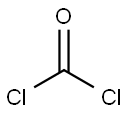| Physical Description |
Phosgene appears as a colorless gas or very low-boiling, volatile liquid with an odor of new-mown hay or green corn. Extremely toxic. Warning properties of the gas inhaled are slight, death may occur within 36 hours (Lewis, 3rd ed., 1993, p. 1027). Prolonged exposure of the containers to intense heat may result in their violent rupturing and rocketing. Rate of onset: Immediate & Delayed (Lungs) Persistence: Minutes - hours Odor threshold: 0.5 ppm Source/use/other hazard: Dye, pesticide, and other industries; history as war gas, corrosive/irritating. |
| Color/Form |
Colorless gas [Note: A fuming liquid below 47 degrees F. Shipped as a liquefied compressed gas]. |
| Odor |
Suffocating odor; when diluted with air there is an odor reminiscent of moldy hay |
| Boiling Point |
47 °F at 760 mmHg (EPA, 1998) |
| Melting Point |
-180 °F (EPA, 1998) |
| Solubility |
Very slightly soluble (NTP, 1992) |
| Density |
1.432 at 32 °F (EPA, 1998) - Denser than water; will sink |
| Vapor Density |
3.4 (EPA, 1998) - Heavier than air; will sink (Relative to Air) |
| Vapor Pressure |
1215 mmHg at 68 °F (EPA, 1998) |
| Henry's Law Constant |
Henry's Law constant = 1.7X10-2 atm-cu m/mole at 24.85 °C; 6.6X10-3 atm-cu m/mole at 4.85 °C |
| Autoignition Temperature |
Not flammable (USCG, 1999) |
| Decomposition |
... When heated to decomposition ... it will react to produce toxic and corrosive fumes of /carbon monoxide/ and /hydrogen chlorides/. |
| Viscosity |
6.8488X10-4 Pa.s at 263.15 K |
| Corrosivity |
Phosgene used in anhydrous equipment with reagents is not corrosive to ordinary metals. In presence of moisture, corrosive conditions will develop rapidly, in which case monel, tantalum, or glass lined equipment may be used. |
| Heat of Vaporization |
3.0783X10+7 J/kmol at 145.37 K |
| Surface Tension |
34.6 mN/m at 0 °C; 20.1 mN/m at 16.7 °C; 17.6 mN/m at 34.5 °C; 15.9 mN/m at 46.1 °C. |
| Ionization Potential |
11.55 eV |
| Odor Threshold |
Odor Threshold Low: 0.12 [ppm] Odor Threshold High: 5.7 [ppm] Odor threshold from AIHA |
| Refractive Index |
Index of Refraction: 1.3561 |
| Kovats Retention Index |
416 |
| Other Experimental Properties |
PHOSGENE GAS LIQUIFIES @ 8 °C |
| Chemical Classes |
Toxic Gases & Vapors -> Acid Halides |
